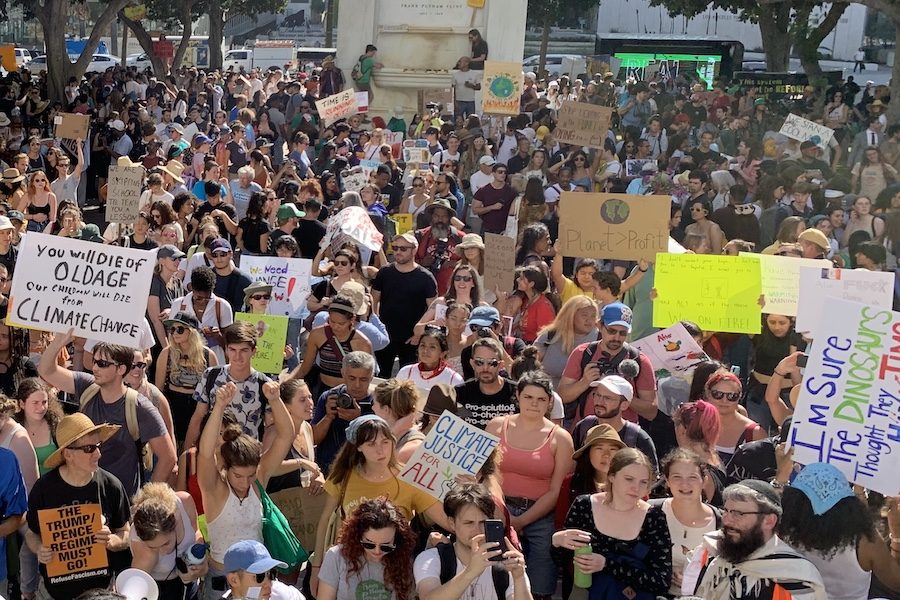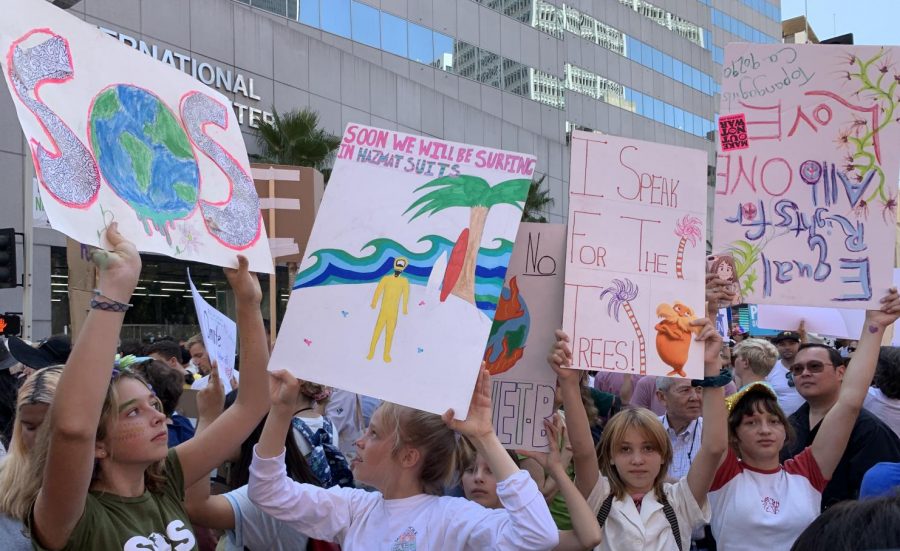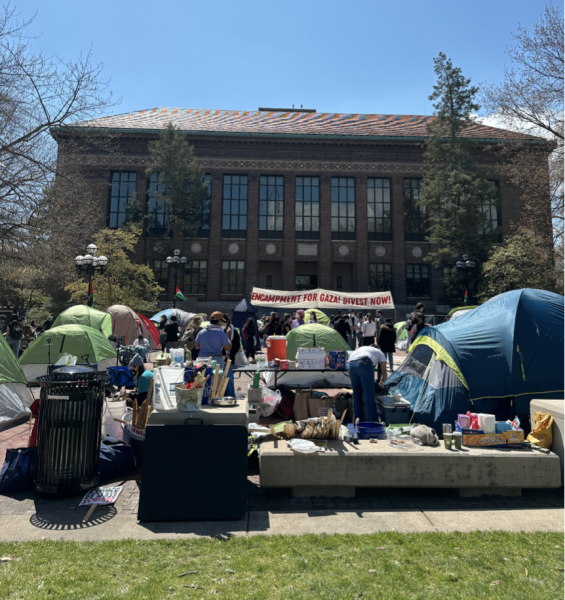Big crowd, small Shalhevet contingent joins worldwide walkout to protest inaction on climate change
“We’re missing our lessons to teach you one,” read one sign at the Youth Climate March on Sep. 20.
The streets of downtown LA were filled with signs and people demanding action combating climate change. But what set this protest apart from many others that have been held in the past was the age of both its organizers and participants.
The global event, part of the Earth Strike which ran from Sept. 20 – 27 with events throughout the world, generated worldwide interest and spurred action after 16-year-old Swedish environmental activist Greta Thunberg endorsed it. The Sep. 20 marches were in advance of an emergency UN Climate Action Summit in New York City on Sep. 23, where Thunberg later spoke.
Los Angeles saw around 2,000 people march through the streets of downtown, starting next to Pershing Square on Olive Street between 5th and 6th streets, and ending on the south lawn of City Hall.
“I’m here because the future is in our hands,” said Gaby Cohen, a senior at Marlborough School in Hancock Park, “and the people that currently have power are not making the necessary changes so that we can have a planet.
“I’m here because I’m terrified of what the world is going to look like when I get a little bit older.”
Only four Shalhevet students attended, including Boiling Point staff. That was disappointing for sophomore Eva Brous-Light, who attended with sophomore Shani Shaham and senior Maia Lefferman .
“I think that we should’ve promoted it more at Shalhevet,” said Eva. “I don’t think people knew about it. But I do think there should have been a much bigger turnout.”
Eva added that she was upset that no Jewish schools came in groups.
“I was pretty disappointed at the Jewish community turnout,” she said, “There weren’t really Jewish schools going in groups together, whereas other schools like Archer and Marlborough organized it with their schools. I feel like Shalhevet should have done something like that.”
The crowd gathered numbered approximately 2000.
The day was filled with chants of “What do we want? Climate justice. When do we want it? Now!” and “Hey hey, ho ho, climate change has got to go.” Despite the foreboding nature of the protesters’ concerns, they generally maintained an upbeat and determined attitude.
High school and college students made up the majority of the protest, often leading cheers, but there were also a sizeable number of adults who seemed content to let the kids take charge.
“I thought it was important to go to this strike,” said Eva, “because recently there’s been a shift in the discourse on climate and it’s been more youth led and I thought it was really important to get involved in that. It’s an issue that I’m really passionate about and something that I think all teenagers should be interested in.”
Organizers in their early 20s in neon vests told protestors where to stand and gave speeches.
“We talk about it’s just going to affect my generation,” said one organizer in a speech. “No — it is affecting people now. It is affecting people across our country. It is affecting people across this world.”
President Trump, who rolled back California vehicle emission standards just last week and also opposes most immigration, was criticized as being part of the problem.
“Guess what? He won’t address climate change — immigration is gonna skyrocket,” said the organizer, whose name was not audible in the crowd. “People are going to have to leave their country because the oceans are rising.
But guess what — so are we. When the oceans rise, we will too.”
After standing from noon until 2 p.m. packed in 82-degree heat next to Pershing Square, the crowd finally began to march.The route wound through downtown, crossing through several streets and causing mass traffic jams. It also climbed several hills.
Loud protesters who seemed to not care much about their personal space stood out on downtown streets usually frequented by busy individuals rarely interacting with one another.
“It seemed a little bit unorganized at the beginning when we were all just standing there,” said Shani Shaham, referring to the two-plus hours of standing next to Pershing Square. “But I think once we actually started marching towards City Hall, it was going really great.”
Toward the end of the 45-minute march, the group reached the south side of City Hall, where Mayor Eric Garcetti spoke from the steps using a megaphone. But it was hard for him to be heard in the immense crowd.
The Los Angeles marchers made up only a portion of the four million protestors at similar events around the world that day. The total is estimated by 350.org, a group that helped organize the protests.
Many countries protesting took aim at their own government not taking enough action to counteract climate change.
According to the New York Times, this included more than 100,000 people marching through the streets of Berlin and similar numbers in New York, London, Paris and Melbourne. Other media reports counted thousands or tens of thousands in Mumbai, Jakarta, Nairobi and Rio de Janeiro, where thousands of protesters targeted President Jair Bolsonaro, who they claim is not doing enough to prevent the burning of the Amazon rainforest. destroying trees that could absorb carbon dioxide.
Shani said the protests around the world made her feel like she was making a difference.
“It was really cool how many people showed up,” said Shani.
“Reading more about it when I got home, and seeing how big it was all around the globe, four million people in different cities and countries, made me feel like a part of something that’s not just small in my school or in my city.”
Messages about how climate change could be solved varied, with some signs calling for “regenerative agriculture,” others for veganism, and many for stricter government legislation. All seemed united around the idea that government was not doing enough, and that it was urgent that the younger generation make the crisis known.
“It’s important to be here because large corporations are not taking a stand so we have to,” said a protestor named Olivia, who would not give her last name.

Jacob Joseph Lefkowitz Brooks was editor-in-chief during the 2019-20 school year and is now a student at the University of Toronto.











